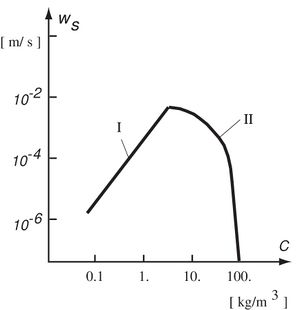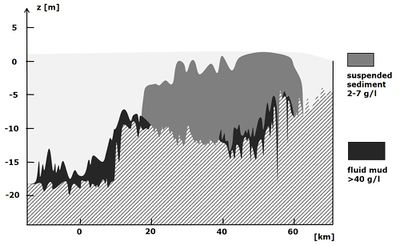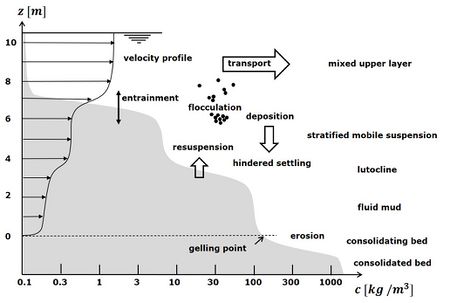Fluid mud
Definition of Fluid mud:
Fluid mud is a high-concentration colloidal suspension of fine sediment particles (< 63 µm with a high percentage of clay particles < 2 µm).
This is the common definition for Fluid mud, other definitions can be discussed in the article
|
Formation fluid mud layer

The concentration of fine cohesive sediments in suspension can become very high close to the seabed. This can be due to[2]
- Convergence of residual fine sediment transport related to tidal asymmetry and estuarine circulation. These processes are a major cause of the formation of a turbidity maximum in estuaries (see Estuarine turbidity maximum).
- Fluidisation of consolidated mud deposits subjected to wave-induced pressure variations. Once formed, the fluid mud layer is maintained by absorbing part of the wave energy. As a consequence, wave action can be strongly damped by absorption of wave energy in the fluid mud layer. The strong wave damping observed at muddy coasts (for example the coasts of Guiana and Surinam, see Coastal mud belt) is caused by the presence of extensive fluid mud banks[3].
- Settling of mudflocs into the near-bottom suspended layer, see Flocculation cohesive sediments.
Through these processes fine sediments become trapped in a colloidal suspension, called fluid mud. This occurs, for example, in periods around neap tide and near the seawater intrusion limit in turbid estuaries.
When mudflocs settle, the suspended sediment concentration near the bottom increases. A dense suspension close to the seabed is formed in which further settling is impeded. There are several theories describing this so-called hindered settling regime[4][5]. When the flocs fill almost all the space, an interconnected matrix of particle bonds is formed in the dense suspension. Sediment settling then becomes impossible. The sediment concentration at which the space is completely filled is called the gelling concentration [math]c_{gel}[/math]. The gelling concentration depends on the nature of the flocs. In some situations a value of 40 g/l is found, but generally the value is higher; [math] c_{gel} \approx[/math] 100 g/l.
The settling velocity in the hindered settling regime depends on several factors. Contacts with other flocs depend on [math]c/c_{gel}[/math]; floc interaction decreases the settling velocity by a factor [math](1-c/c_{gel})^m [/math]. The weight of the floc in the dense suspension is lower than the weight in clear water by a factor [math](1-c/\rho_s)[/math], where [math]\rho_s[/math] is the density of the suspension. The viscosity of the suspension is increased relative to the clear water viscosity [math]\nu[/math] [8]. This increase amounts to a factor [math](1+2.5 c/c_{gel})[/math], according to experimental evidence. Altogether this leads to the following expression for the hindered settling velocity of fine cohesive sediment:
[math]w_s(c) = w_s(0) \Large\frac{(1-c/\rho_s)(1-c/c_{gel})^m}{1+2.5 c/c_{gel}}\normalsize , \qquad (1) [/math]
where for the exponent the value [math]m=2[/math] is used.
A similar but more elaborated formula was proposed by Camenen[9]; this formula includes the possibility that the flocs do not entirely fill all the space when the gelling point is reached.
Due to hindered settling, the floc settling velocity decreases for concentrations around 10 kg/m[math]^3[/math]. The maximum in the settling velocity curve (Fig. 1) implies that mass settling to the fluid mud layer converges to a concentration exceeding 10 kg/m[math]^3[/math]. The suspended sediment concentration in fluid mud may even reach 250 g/l.
Buoyancy suppresses turbulent exchange between layers of different density, stimulating the formation of a lutocline - a sharp interface between layers with different suspended sediment concentrations, see Fig. 2. The density difference between the layers is thereby further increased as an auto-enhancing process. Winterwerp[10] argues that the density increase may finally exceed the sediment carrying capacity of the lower layer, leading to the collapse of this layer and the formation of a mud bed.
For further details on mud transport, mud bed formation and destruction see Dynamics of mud transport.
Hydrodynamics of fluid mud
As long as the concentration is below the gel point, fluid mud can flow as a viscous near-bed layer, entrained by the flow or by pressure gradients of the overlying water mass. Fluid mud layers can be entrained by near-bottom currents over considerable distances without being dispersed over the whole water column[11].
If the seabed is sloping, the fluid mud slides down as a turbidity current under the influence of gravity. In shallow water, fluid mud absorbs wave energy.
If near-bottom currents are absent or very weak, the fluid mud layer consolidates and becomes part of the bed substrate. The consolidation process can take a long time, and is approximately proportional to the square of the layer thickness.

A seabed covered with fluid mud offers almost no resistance to the flow in the overlying layer. Prandle[13] related the friction coefficient to the mud content of the sediment bed in many UK estuaries; he found evidence for a strong decrease of the friction coefficient with increasing mud fraction. The reduction in flow resistance is mainly due to the suppression of turbulence at the lutoclines[14]. The friction factor [math]c_D[/math] can be reduced by a factor 10 or even more.
Fluid mud layers are frequently observed at harbour entrances and in artificially deepened navigation channels[15][16], see Siltation in harbors and fairways. Fluid mud layers in estuaries often form during neap tides in the high-water and low-water slack zones where saline and fresh water converge and where fine sediments are trapped, see Fig. 3 and Estuarine turbidity maximum.
Related articles
- Dynamics of mud transport
- Sediment deposition and erosion processes
- Flocculation cohesive sediments
- Coastal and marine sediments
- Mud
- Estuarine turbidity maximum
- Characteristics of muddy coasts
- Coastal mud belt
References
- ↑ Mehta, A.J. 1986. Characteristics of cohesive sediment properties and transport processes in estuaries. In: Estuarine cohesive sediment dynamics. Ed.: A.J.Mehta. Lecture notes coastal and estuarine studies 14, Springer-Verlag, Berlin: 427-445
- ↑ McAnally, W.H., Friedrichs, C., Hamilton, D., Hayter, E., Shrestha, P., Rodriguez, H., Sheremet, A. and Teeter, A. 2007. Management of Fluid Mud in Estuaries, Bays, and Lakes. I: Present State of Understanding on Character and Behavior. J. Hydr. Eng. 133: 9-22
- ↑ Traykovski, P., Trowbridge, J. and Kineke, G. (2015) Mechanisms of surface wave energy dissipation over a high-concentration sediment suspension. J. Geophys. Res. Oceans 120: 1638–1681
- ↑ Winterwerp, J.C. 2002. On the flocculation and settling velocity of estuarine mud. Cont. Shelf Res. 22: 1339-1360
- ↑ Dankers, P.J.T. and Winterwerp, J.C. 2007. Hindered settling of mud flocs: Theory and validation. Continental Shelf Res. 27: 1893-1907
- ↑ Gust, G. and Walger, E. 1976. The influence of suspended cohesive sediments on boundary-layer structure and erosive activity of turbulent seawater flow. Mar.Geol. 22: 189-206
- ↑ Li, M.Z. and Gust, G. 2000. Boundary layer dynamics and drag reduction in flows of high cohesive sediment suspensions. Sedimentol. 47: 71-86
- ↑ Dyer, K.R., Christie, M.C. and Manning, A. J. 2004. The effect of suspended sediment on turbulence within an estuarine turbidity maximum. Est. Coast. Shelf Sci. 59: 237-248
- ↑ Camenen, B. and Van Bang, D.P. 2011. Modelling the settling of suspended sediments for concentrations close to the gelling concentration. Continental Shelf Res. 31: 106-111
- ↑ Winterwerp, J.C. 2001. Stratification effects by cohesive and non-cohesive sediments. J.Geophys.Res. 106: 22559-22574
- ↑ Kirby, R. and Parker, W.R. 1983. Distribution and behaviour of fine sediment in the Severn Estuary and Inner Bristol Channel. U.K.Can.J.Fish.Aquat.Sci. 40 (suppl.): 83-95
- ↑ Bertier, C. 2011. Dynamique et suivi du bouchon vaseux dans l’estuaire de la Loire. Séminaire Technique sur le transport sédimentaire: Principes et expériences sur le bassin Ligrien, Vierzon 24 Novembre 2011
- ↑ Prandle, D. 2003. Relationships between tidal dynamics and bathymetry in strongly convergent estuaries. J.Phys.Ocean. 33: 2738-2750
- ↑ Winterwerp, J.C., Manning, A.J., Martens, C., De Mulder, T. and Vanlede J. 2006. A heuristic formula for turbulence-induced flocculation of cohesive sediment. Estuarine, Coastal and Shelf Science 68: 195-207
- ↑ Parker, G., Lanfredi, N.W. and Swift, D.J.P. 1982. Seafloor response to flow in a southern hemisphere sand ridge field: Argentine inner shelf. Sed.Geol.33: 195-216
- ↑ De Jonge, V.N., Schuttelaars, H.M., Van Beusekom, J.E.E., Talke S.A. and De Swart, H.E. 2014. The influence of channel deepening on estuarine turbidity levels and dynamics, as exemplified by the Ems estuary. Estuarine, Coastal and Shelf Science 139: 46-59
Please note that others may also have edited the contents of this article.
|
